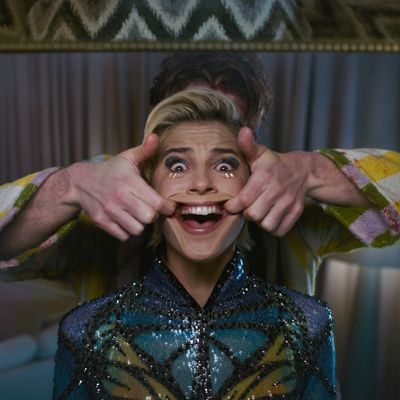
Smile 2 has one genuinely good idea, which is that the everyday life of a messed-up pop megastar is indistinguishable from the shrieking terrors of a supernatural horror movie. Whenever director Parker Finn runs with that thought, the film has a nice, disorienting punch. The victims of horror movies usually suffer in private, stalked through dark empty houses or remote forests or abandoned corridors. Smile 2’s superstar protagonist, however, is constantly surrounded by people: hangers-on, assistants, fans, and gawkers. She suffers in full view of the public, with people all around her who could presumably help. That turns out to be just as unsettling as an eerie lake or a cabin in the woods, and more metaphorically potent to boot.
The film follows a few days in the life of global pop icon Skye Riley (Naomi Scott), who is returning to performing after a period in rehab and a lengthy hiatus due to a gruesome car crash that scarred her and killed her actor boyfriend Paul (Ray Nicholson). But when her old friend and dealer Lewis (Lukas Gage) cracks a sinister smile before gleefully bashing his own head open with a 35-pound weight plate, things start to go truly haywire. Skye begins seeing Lewis’s figure lurking around her, as well as that of the long-deceased Paul. Most importantly, she starts to see the smiles — those unsettling, unnatural, wide grins from the first movie that tell us that demonic possession may be afoot.
At its best, Smile 2 keeps us guessing as to whether Skye is being haunted or simply dealing with the craziness of fandom. Is the sweaty, clingy creep who wants her to sign his T-shirt and won’t leave her alone a monster from the beyond, or just your average stalker? What about her incessantly supportive mother (Rosemarie DeWitt) or her obsequious assistant (Miles Gutierrez-Riley)? Then there’s the fact that Skye is a recovering addict. (The only reason she visits a dealer is because she’s not allowed prescription-strength pain meds but is still in agony from all her post-accident surgeries.) Could these things following her be drug-induced hallucinations? Okay, maybe “keeps us guessing” is overstating it: We know the true answer to all these questions, even if Skye doesn’t. But while the film is too much of a standard-issue horror movie to keep things ambiguous, it does make us think about how the phony smiles that surround celebrities aren’t too different from the evil smiles that surround the protagonist-victims of the Smile franchise.
Director Finn has clearly given this some thought, and he wisely doesn’t just revisit the narrative stations of the first picture. He made his feature directorial debut with that film, a surprise hit in 2022 that was an expansion of a short he’d made two years earlier. But Smile ran out of steam after establishing its nifty premise of an unseen viral demon that plastered disturbing grins on people’s faces before making them kill themselves. A world in which other people’s smiles became monstrous threats was a brilliant visual idea, one of both eerie immediacy and symbolic charge, but the movie eventually lost itself amid the predictable requirements of a genre picture.
Unfortunately, Smile 2 is similarly torn between its novel premise and the base demands of horror. It’s hard not to watch Skye’s spiraling reality and think of all the young nonfictional celebrities who’ve melted down in front of our eyes over the years: the Britneys, the Lindsays, the Amandas and Aarons and others. And yet while Scott’s appropriately freaked-out performance helps, the film never quite manages to make us care for Skye, in part because she’s a victim right from the start and things never settle down long enough for us to get any sense of her as a character. The film’s empathy exists mostly in the abstract, as Finn overdoes Skye’s fraying consciousness. Right as we should be feeling something for her increasingly helpless situation, he bludgeons us with ineffective jump scares — cheap, haphazard ones, awkwardly telegraphed and accompanied by loud booms and crashes on the soundtrack — and increasingly meaningless dream visions.
Like he did in the first film, the director has one go-to move that he relies on over and over again: to follow one particular narrative path before revealing that — psych! — it didn’t really happen. He wants it to be a rug-pulling mindfuck, but the more it occurs, the more it devalues everything we’re seeing. As Skye becomes increasingly unable to tell what’s actually happening and what’s a waking nightmare, we should feel more for her, and we should feel more with her. Instead, we lose interest, as the whole thing becomes pointless and even a little cynical and cruel. The movie ultimately scuttles its own ambitions.
More Movie Reviews
- The Thriller Drop Is a Perfect Addition to the Bad-First-Date Canon
- The Accountant 2 Can Not Be Taken Seriously
- Another Simple Favor Is So Fun, Until It Gets So Dumb


